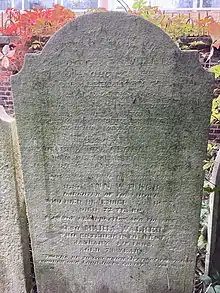George Walker (December 24, 1772 – February 8, 1847) was an English gothic novelist and publisher.
Life

He was born in Falcon Square, Cripplegate, London, England. He worked as a bookseller and music publisher, into which business his son George (1803–1879) also entered. His writings were anti-reform, reacting to writers such as William Godwin and Thomas Holcroft.[1]
He died on the 8th February 1847 and was buried on the western side of Highgate Cemetery.
The Vagabond (1799)
Walker's anti-Jacobin novel The Vagabond: A Novel (1799) anachronistically sets the Gordon Riots of 1780 amidst the political events of the late 1790s. After attending a lecture by "Citizen Ego", a character based on John Thelwall, its narrator unwittingly becomes a prominent figure in the riots. Inverting radical accounts of the significance of the riots, The Vagabond presents them as solely destructive and acquisitive. Later, the hero's mentor Stupeo, based on William Godwin, attempts to establish a pantisocratic community in the American wilderness, but is captured and burned at the stake by Native Americans.[2]
In the novel's dedication, Walker describes the novel as "an attempt to parry the Enemy with their own weapons" and to undermine radicalism's political romance".[3] The literary critic Ian Haywood reads The Vagabond as evidence that the Gordon Riots "still exerted a powerful hold on popular memory" at the time of its publication.[3]
Books
- The Romance of the Cavern, 1792
- The Haunted Castle, 1794
- The House of Tinian, 1795
- Theodore Cyphon, or The Benevolent Jew, 1796
- Cynthelia, or a Woman of Ten Thousand, 1797
- The Vagabond, 1799
- The Three Spaniards, 1800
- Poems on Various Subjects, 1801
- Don Raphael, 1803
- Two Girls of Eighteen, 1806
- The Travels of Sylvester Tramper in Africa, 1813
- The Adventures of Timothy Thoughtless, 1813 (for children)
- The Battle of Waterloo, A Poem, 1815[1]
References
- 1 2 Harvey, A. D. (1977). "George Walker and the Anti-Revolutionary Novel". The Review of English Studies. 28 (111): 290–300. doi:10.1093/res/XXVIII.111.290. JSTOR 514722.
- ↑ Haywood, Ian (2006). Bloody Romanticism: Spectacular Violence and the Politics of Representation, 1776–1832. Palgrave Macmillan. pp. 196–198. ISBN 9781403942821.
- 1 2 Haywood 2006, p. 196.
- . Dictionary of National Biography. London: Smith, Elder & Co. 1885–1900.